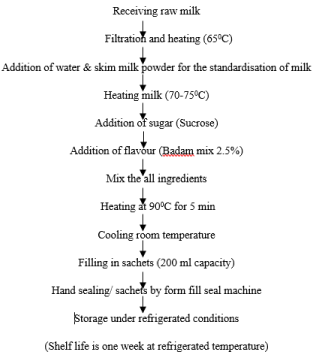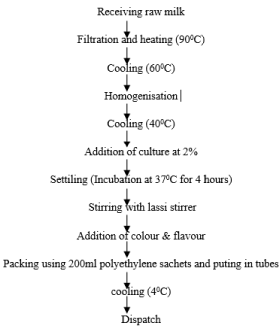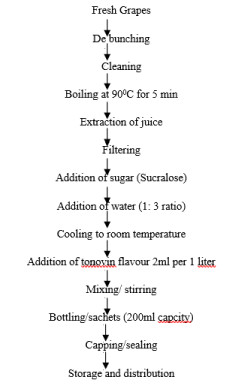
Special Article – Dairy Products
Austin J Nutri Food Sci. 2019; 7(8): 1133.
Development of Low Calorific Dairy Products and Fruit Juice
Somavarapu S1* and Kanchana K1
Department of Food Technology, Vikrama Simhapuri University, India
*Corresponding author: Somavarapu S, Department of Food Technology, Vikrama Simhapuri University, India
Received: November 23, 2019; Accepted: December 19, 2019; Published: December 26, 2019
Abstract
Every industry relies to some extent on the development of new or modified products. Milk, lassi, badam milk, juices and dairy products plays a significant role as a source of animal protein in the average Indian diet, which is predominantly vegetarian. They are rich sources of energy and important in building bone mass in children and adolescents. Because of higher ambient temperatures prevailing in Indian sub-continent, ancient Indians developed more stable products from fruits and milk for conservation of its nutritional goodness. Innumerable types of traditional dairy products are prepared in our country. Some of them have attained national status while many others are still very region specific. Encouragement of new low calorific milk, fruit juices and dairy products and improving value added product is the aim of the present work.
Keywords: Milk; Lassi; Badam milk; Fruit juices; Low calorie dairy products
Introduction
Consumers’ perception about the real importance of a balanced diet and healthy lifestyle on disease prevention, health maintenance, and longevity promotion has driven the development of multiple and increasingly deepen studies [1,2]. Foods, food ingredients, and even bioactive molecules with health promoting abilities present a large demand by worldwide consumers [3]. Functional foods make part of daily diet, both as natural, whole, or unmodified foods; however, they may also be used and/or incorporated as food constituents, added and/or removed by technological or biotechnological procedures that modulate their bioavailability, focusing on the improvement of their biological effects [4-7]. Several food groups, such as meat and fish products, ice cream, cheese, yogurt, and other dairy products present very interesting chemical characteristics and nutritional composition that triggers the focus of researchers to the incorporation and application of bioactive molecules in those food matrices.
Dairy products are amongst the most commonly tested and selected food groups toward the incorporation of food ingredients for functional purposes. Milk, cream, yogurt, kefir, powdered milk, condensed milk, ricotta, butter, casein, fermented dairy drinks, infant milk formula, colostrum, cheese, and ice creams are the most common traditional dairy products considered as functional foods [8,9]. All these products have on their chemical composition recognized ingredients that provide, besides the nutritional benefits, a considerable improvement on human health and well-being [8]. Numerous nutrients are present on dairy food products, being vitamins, minerals, and proteins the most abundant ones. However, some preparations present active ingredients with low availability and/or nutritional deficits of these constituents, being milk fortified with calcium and vitamin-D (fortified product) one of the most representative examples of this situation [10,11]. Moreover, the incorporation of milk supplements and milk based food products, such as probiotic bacteria and prebiotic polysaccharides, omega-3 fatty acids, and other compounds, is becoming increasingly common (enriched product) [10,11]. Moreover, there are some situations in which some deleterious components need to be removed, reduced, or replaced by another substance with beneficial effects, for example, fibers as fat releasers in ice cream products (altered products) [10-12]. Curiously, functional dairy foods are virtually found in all these types of functional food categories, despite they are not homogeneously scattered over all segments of the growing market.
Thus, the objective of the present work is preparation of low calorific badam milk, lassi, grape juice and ice cream and qualitative analysis of badam milk, lassi, grape juice and ice cream.
Methodology
Badam milk
Badam milk recipe is a healthy, protein packed, delicious flavourful milk with the goodness of almonds, cardamoms and saffron.
Preparation: The raw cow milk received is checked by quality control person by subjecting. The milk to tests like organoleptic and cool on boiling (COB) etc., do determine whether the milk is suitable for processing or not. Then the milk is filtered to remove any dirt and extraneous particles and heated to 650C. Water and SNP is added for the standardisation. This is than heated to 70-750C and sugar (Sucrose) is added.
Badam mix is added @2.5%, which even serves as a flavouring agent. The ingredients are mixed and heated to 900C for 5 min. Then the mix ix allow cooling in room temperature. The finished product is the filled in sachets and stored at refrigerated condition (Figure 1).

Figure 1: Preparation of badam milk.
Lassi
Preparation: Traditionally, lassi is prepared by stirring Dahi with small quantity of cold water. Usually cow milk is taken and boiled. Milk is then cooled to room temperature and pinch of previous day curd added at the rate of 0/5-2% level. The milk is set for overnight. Then the curd is broken and beaten with small amount of chilled water to a smooth consistency. Meanwhile sucrose is added flavour (Vanilla) and colour are added and product is served under chilled condition (Table 1 & Figure 2).

Figure 2: Flow chart for preparation of Lassi.
Ingradients
Quantity
Curd
2 L
Vanilla
5 ml
Sucrose
1.20grams
Table 1: Ingradients in lassi preparation.
Ice cream
Preparation: Milk received should be tested for COB (Clot on Boiling) test and if it is positive the milk will be discarded, if it is negative it will be further processed for the preparation. Ingredients that are taken for the preparation of ice cream should be superior quality, mix must be calculated as per the specified standard i.e., cream is added to milk at 450C, SMP, stabilizer and sugar (Sucrose) are mixed separately and the dried material mix is added at 65- 700C. The prepared mix has to be pastured indirectly at 750C at 10 min and homogenized, then cooling the mix and aging for 4C for 3 hours required amount of flavour has to be added before freezing the mix then -50C for 20 min, then filling and packing in cups then immediately handed to -190C and kept storage as ice cream at around -230C (Figure 3).

Figure 3: Flowchart for the preparation of Ice cream.
Grape juice
Preparation: The raw grapes received are checked for their quality, to determine whether they are suitable for preparing or not. Then de bunching and cleaning is done. The grapes are then kept in water and boiled at 900C for 5 min. Then the grapes are subjected to pulping for extraction of juice. The juice is filtered and sugar (Scuolose) added. Then, water is added and cooled to room temperature. Tonovin flavour and colour is added 0.2%. The finished product is the filled in polyethylene sachets either by hand sealing or sealed with the help of from fill seal machines and stored at refrigerated conditions (Table 2 & Figure 4).

Figure 4: Flowchart in the preparation of Icecream.
Ingredients
Quantity
Grapes
1kg
Water
3 liter
Sucralose
0.52 grams
Tonovin colour
10 ml
Table 2: Ingredients in Grape juice preparation.
Results
Badam milk
From table 3, it is observed that the Badam milk prepared contains low amount of fat, sugar and rich in fibre and suitable for diabetic person (Table 3).
Observed value (%)
Standard value (%)
Fat
2.2
1.5-3.25
Acidity
0.252
0.115-0.252
Moisture
80-46
77.75-74.30
Total solids
19.54
22.22-25.70
Ash
0.025
0.76-1.59
PH
6.22
6.2-7.1
Table 3: Comparison of standard values with observed values of Badam Milk.
Lassi
Lassi is a fermented dairy product, which is enjoyed as hot weather refreshment, mostly taken with lunch. It remains good only for a day or two at room temperature. Under refrigeration, the keeping quality of lassi is extended considerably. Further extension of shelf life is achieved by UHT processing after fermentation, and packaging aseptically. Wheying off may occur but it can be avoided by using a suitable stabilizer and proper processing conditions. Application of safe, and low cost bio-preservative may be recommended to extent shelf life of lassi. In order to meet the seasonal and regional requirements of lassi, a technology is to be developed for the manufacture of lassi powder, which upon reconstitution yields lassi like beverage (Table 4).
Observed value (%)
Standard value (%)
Fat
4
1.5-3.8
Acidity
0.504
0.145
Moisture
80.02
87.28
Total solids
19.98
12.72
Ash
0.025
0.715
PH
6.6
6.2-7.1
Table 4: Comparison of standard values with observed values of Lassi.
Ice cream
Thus for the ice cream produced the observed value of fat and total solids fall within the standard value and hence suitable for a diabetic person (Table 5).
Observed value (%)
Standard value (%)
Fat
10.5
10-12
Moisture
62.88
64-62
Total solids
37.112
36-38
Ash
0.479
0.47-0.86
Protein
2.5
SNF
12
Table 5: Comparison of standard values with observed values of Icecream.
Grape juice
For the grape juice prepared, the observed fat is far less than the standard value but total solids are more than the standard value (Table 6).
Observed value (%)
Standard value (%)
Fat
10.5
84-85
Moisture
81.287
15-16
Total solids
18.763
0.121
Ash
0.119
0.47-0.86
Brix raio
18.6
16-18
PH
3.60 at 31.90C
2.92-3.68
Table 6: Comparison of standard values with observed values of grape juice.
Conclusion
Functional foods aim at achieving a particular function of treating a disease or a pathological condition. Milk, lassi, badam milk, juices and dairy products play a significant role as a source of animal protein in the average Indian diet, which is predominantly vegetarian liked by almost all people. They are rich sources of energy. Children and adolescents should be encouraged to consume fruits, milk products because this is the period of their lives in which they are building their peak bone mass and developing lifelong habits. Because of higher ambient temperatures prevailing in Indian sub-continent, ancient Indians developed more stable products from fruits and milk for conservation of its nutritional goodness.
Diabetes mellitus, commonly known as diabetes, is a metabolic disease that causes high blood sugar. The justification for this work is to produce milk, lassi, badam milk, juices and dairy products that are of low sugar, fat and calorific value, thus suitable for diabetic persons too. They have a great urge to eat sugars but unfortunately, they ought to suppress the urge. Thus, the present products would prove a commercial success, as they will add something to the overall sales of fruit juices, milk and dairy products.
References
- Hemme T, Otte J. Status of and prospects for smallholder milk production-a global perspective. Rome: FAO. 2010.
- FAO. Food outlook global market analysis. Rome: FAO. 2012.
- Davies KM, Heaney RP, Recker RR, Lappe JM, Barger-Lux MJ, Rafferty K, et al. Calcium intake and body weight. J Clin Endo- crinol Metab. 2000; 85: 4635-4638.
- Parikh SJ, Yanovski JA. Calcium intake and adiposity. Am J Clin Nutr. 2003; 77: 281-287.
- Major GC, Alarie F, Dore J, Phouttama S, Tremblay A. Supplementa- tion with calcium + vitamin D enhances the beneficial effect of weight loss on plasma lipid and lipoprotein concentrations. Am J Clin Nutr. 2007; 85: 54-59.
- Pereira MA, Jacobs DR Jr, Van Horn L, Slattery ML, Kartashov AI, Ludwig DS. Dairy consumption, obesity, and the insulin resistance syndrome in young adults: the CARDIA study. JAMA. 2002; 287: 2081-2089.
- Zemel MB, Shi H, Greer B, Dirienzo D, Zemel PC. Regulation of ad- iposity by dietary calcium. FASEB J. 2000; 14: 1132-1138.
- Shahar DR, Abel R, Elhayany A, Vardi H, Fraser D. Does dairy calcium intake enhance weight loss among overweight diabetic patients? Dia- betes Care. 2007; 30: 485-489.
- Shahar DR, Schwarzfuchs D, Fraser D, Vardi H, Thiery J, Fiedler GM, et al. Dairy calcium intake, se- rum vitamin D, and successful weight loss. Am J Clin Nutr. 2010; 92: 1017-1022.
- Zemel MB. Role of dietary calcium and dairy products in modulating adiposity. Lipids. 2003; 38: 139-146.
- Zemel MB, Richards J, Mathis S, Milstead A, Gebhardt L, Silva E. Dairy augmentation of total and central fat loss in obese subjects. Int J Obes (Lond). 2005; 29: 391-397.
- Zemel MB, Thompson W, Milstead A, Morris K, Campbell P. Calcium and dairy acceleration of weight and fat loss during energy restriction in obese adults. Obes Res. 2004; 12: 582-590.